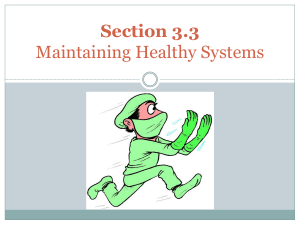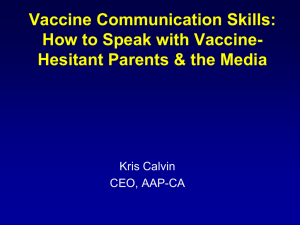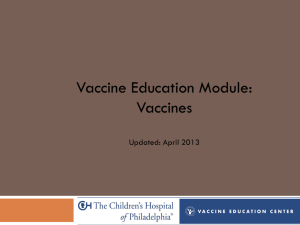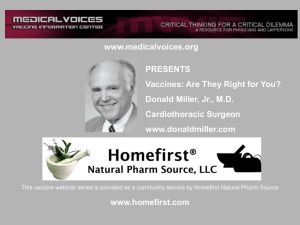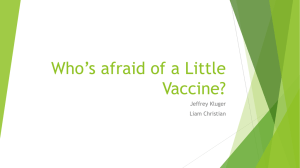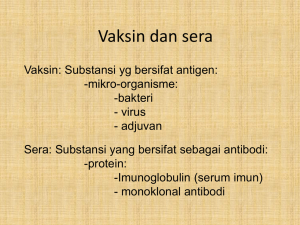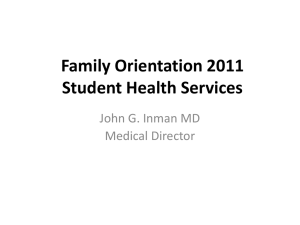VACCINES
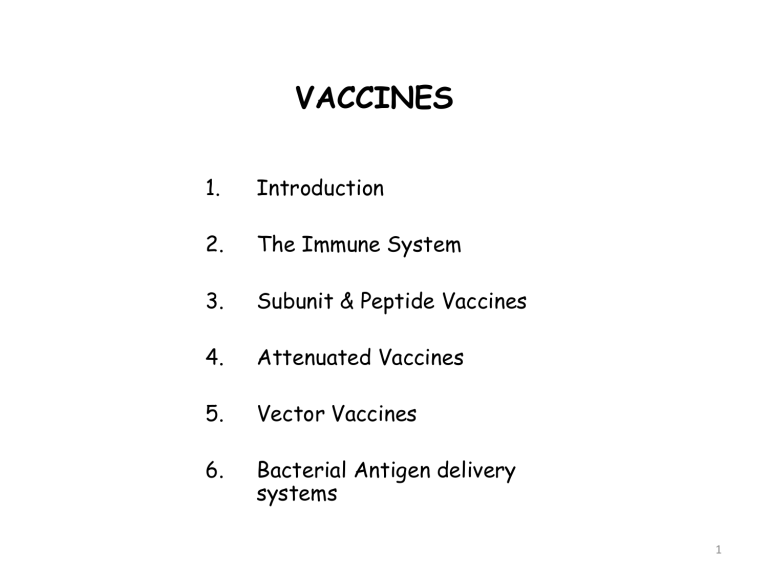
VACCINES
1.
Introduction
2.
The Immune System
3.
Subunit & Peptide Vaccines
4.
Attenuated Vaccines
5.
Vector Vaccines
6.
Bacterial Antigen delivery systems
1
VACCINES
• Immunization: a procedure designed to increase concentrations of antibodies and/or effector Tcells which are reactive against infection (or cancer).
• Immunization procedure called vaccination and the immunizing agent called vaccine (or “serum” in historical references)
2
VACCINES
Introduction
Discovery of Vaccination
• Discovered in 1796 by
Dr. Edward Jenner
• Tested empirical knowledge: mild cattle disease cowpox protects against deadly human disease smallpox
• scratching liquid from cowpox sores into the boy's skin -> full protection against smallpox
3
Innate
(Nonspecific)
VACCINES
The Immune system
Immune System
Adaptive
(Specific)
Protects/re-exposure
Cellular Components Humoral Components Cellular Components Humoral Components
Interactions between the two systems
4
VACCINES
The Immune system
Innate versus Adaptive Immunity
Innate Immunity Adaptive Immunity
•
No time lag
•
Not antigen specific
•
No memory •
•
•
A lag period
Antigen specific
Development of memory
5
VACCINES
The Immune system
Innate Immune System
First-line defense: physical and chemical barrier
The first-line defense includes barriers to infection, such as skin and mucus coating of the gut and airways.
Second-line defense:
Phagocytic cells phagocytic cells (Myeloid cells) (macrophages and neutrophil granulocytes) can destroy (phagocytose) foreign substances. Phagocytosis involves digestion of the bacterium by using enzymes.
Anti-microbial proteins
Anti-microbial proteins are activated if a pathogen passes through the barrier offered by skin. There are several classes of antimicrobial proteins, such as acute phase proteins (for example, proteins that enhance phagocytosis), lysozyme, and the complement system.
The complement system is a very complex group of serum proteins, which is activated in a cascade fashion. Three different pathways are involved in complement activation:
A cascade of protein activity follows complement activation -> destruction of the pathogen and inflammation
Interferons are also anti-microbial proteins.
-> secreted by virus-infected cells -> diffuse rapidly to neighboring cells -> inhibit the spread of the viral infection.
6
VACCINES
The Immune system
Adaptive Immune System
The adaptive immune system, also called the "acquired immune system", ensures that most mammals that survive an initial infection by a pathogen are generally immune to further illness caused by that same pathogen.
The adaptive immune system is based on dedicated immune cells termed leukocytes (white blood cells) that are produced by stem cells in the bone marrow, and mature in the thymus and/or lymph nodes. It is in the lymph nodes where antigen is usually presented to the immune system.
7
VACCINES
Cells of the Immune System
Immune System
Myeloid Cells Lymphoid Cells
Granulocytic Monocytic T cells B cells
Natural Killer cells
Neutrophils
Basophils
Eosinophils
Macrophages
Kupffer cells
Dendritic cells
Helper cells
Suppressor cells
Cytotoxic cells
Plasma cells
8
Monocyte
VACCINES
Development of the Immune System
Granulocyte nk
CD8 +
CD4 + thymus
TH2 myeloid lymphoid
B-Cells
TH1
CTL
9
VACCINES
The Immune System
What Happens during an infection?
• Innate Immunity activated
– macrophages slip between cells [extravasation] to arrive
– cytokine chemicals attract other “troops” [chemotaxis]
– histamine chemicals dilate blood vessels for easier access to injury
[vasodilatation]
10
VACCINES
The Immune System
Macrophages (The “big eaters”)
• Phagocytic cells able to ingest small foreign invaders
– neutrophils
– monocyte
• they release cytokines that enhance the immune response
• Mast cells /basophils
– release histamine that dilates blood vessels
– causes redness [erythrema], swelling
[edema], and heat [fever]
• Call for help from the ADAPTIVE IMMUNE System
-> results in a coordinated successful defense !
• Major players . . . the B lymphocytes
11
VACCINES
The Immune System
The Adaptive Immune system
1.
Humoral immune system : -> acts against bacteria and viruses using immunoglobulins
(also known as antibodies ) -> produced by B cells .
2. Cellular immune system : -> destroys intracellular pathogens (such as virus-infected cells and mycobacteria – causing tuberculosis) using T cells (also called "T lymphocytes"; "T" means they develop in the thymus ).
There are two major types of T cells:
Cytotoxic T cells (TC cells): -> recognize infected cells by using T cell receptors to probe cell surfaces (-> Major Histocompatability Complex [MHC]) . If they recognize an infected cell, they release granzymes (proteases) to trigger that cell to become apoptotic ("commit suicide")
Helper T cells (TH cells): -> activate macrophages and also produce cytokines
(interleukins) that induce the proliferation of B and T cells.
-> recognize infected cells of the immune system by using HelperT cell receptors to probe cell surfaces (-> Major Histocompatability Complex [MHC])
12
VACCINES
The Immune System
The Adaptive Immune system
Activated B cells differentiate into . . .
– Antibody producing cells [attack mode]
– Memory cells [remembers & future protection]
Antigen & T-helper cell antibodies memory
13
VACCINES
Principle of Vaccination
• A vaccine renders the recipient resistant to infection.
• During vaccination a vaccine is injected or given orally.
• The host produces antibodies for a particular pathogen.
• Upon further exposure the pathogen is inactivated by the antibodies and disease state prevented.
• Generally to produce a vaccine the pathogen is grown in culture and inactivated or nonvirulent forms are used for vaccination.
14
VACCINES
Principle of Vaccination
Immunization:
• When performed before exposure to an infectious agent (or soon after exposure in certain cases), it is called
immunoprophylaxis,
• intended to prevent the infection.
• When performed during an active infection (or existing cancer), it is called immunotherapy, intending to cure the infection (or cancer)
15
VACCINES
Principle of Vaccination
Types of Immunity:
-> Two mechanisms by which immunization can be achieved
• Passive immunization:
– Protective Abs --> non immune recipient
– No immunological memory
• Active immunization:
– Induction of adaptive immune response, with protection and memory.
16
VACCINES
Principle of Vaccination
Passive versus active immunization:
-> TYPE ACQUIRED THROUGH Passive Immunization –
-> Natural maternal serum/milk
-> Artificial immune serum
-> Type ACQURIED THROUGH Active Immunization –
-> Natural infection
-> Artificial infection*:
Attenuated organisms (live) inactivated organisms (dead)
Cloned genes of microbiological antigens
Purified microbial macromolecules
Synthetic peptides
DNA
*Artificial refers to steps involving human intervention
17
VACCINES
Principle of Vaccination
Mechanism of Vaccination:
Establish resistance to virus/pathological organism by evoking an immune response
1. Give host a foreign organism/protein in non-infectious form -> active immunization
2. Antibodies are generated Ab binds to surface proteins of organism
-> passive immunization
Other vaccination components:
• Adjuvant: chemicals in the vaccine solution that enhance the immune response
– Alum – Ag in the vaccine clumps with the alum such that the Ag is released
– slowly, like a time-release capsule
– gives more time for memory cells to form
18
• Traditional Vaccines :
VACCINES
Principle of Vaccination
– Grow in animals (vaccinia in calves for smallpox; rabbit brains for rabies)
– Simple bacterial culture
(Cholera vibrio) then inactivation
– Grow in eggs (influenza, vaccinia) then inactivate
>100 million eggs used for influenza in the USA every year
19
VACCINES
Principle of Vaccination
Limitations To Traditional Vaccines:
-> can’t grow all organisms in culture
-> safety to lab personnel
-> Expense
-> insufficient attentuation (living agent altered to become harmless or less virulent)
-> reversion to infectious state
-> need refrigeration
-> do not work for all infectious agents
-> infants/children receive them – immature immunity
20
VACCINES
Principle of Vaccination
New Generation of Vaccines:
• Recombinant DNA technology is being used to produce a new generation of vaccines.
Virulence genes are deleted and organism is still able to stimulate an immune response.
Live nonpathogenic strains can carry antigenic determinants from pathogenic strains.
If the agent cannot be maintained in culture, genes of proteins for antigenic determinants can be cloned and expressed in an alternative host e.g. E. coli.
21
VACCINES
Principle of Vaccination
Recombinant Vaccines:
1.
Subunit Vaccines peptide vaccines
Genetic immunization
2. Attenuated Vaccines
3. Vector Vaccines
4. Bacterial Antigen Delivery Systems
-> ghosts -> delivery systems (next semester)
22
VACCINES
Principle of Vaccination
23
VACCINES
Subunit/Peptide Vaccines
•Do NOT use entire virus or bacteria (pathogenic agent)
•Use components of pathogenic organism instead of whole organism
•Advantage: no extraneous pathogenic particles i.e. DNA
•Disadvantage: Is protein the same as in situ? -> Cost?
24
VACCINES
Subunit/Peptide Vaccines
Development of Subunit vaccines based on the following observation:
• It has been showed that the capsid or envelope proteins are enough to cause an immune response:
Herpes simplex virus envelop glycoprotein O.
Foot and mouth disease virus capsid protein (VP1)
Extracellular proteins produced by Mycobacterium tuberculosis.
• Subunit Vaccines
• Antibodies usually bind to surface proteins of the pathogen or proteins generated after the disruption of the pathogen.
• Binding of antibodies to these proteins will stimulate an immune response.
• Therefore proteins can be use to stimulate an immune response.
25
VACCINES
Subunit/Peptide Vaccines
Example for a subunit vaccine -> Tuberculosis
• Tuberculosis is caused by Mycobacterium tuberculosis.
• The bacterium forms lessions in the tissues and organs -> causing cell death.
Often the lung is affected.
• About 2 billion people are infected and there are 3 million deaths/year.
• Currently tuberculosis is controlled by a vaccine called BCG (Bacillus Calmette-
Guerin) which is a strain of M. bovis.
• M. bovis often responds to diagnostic test for M. tuberculosis.
• Six extracellular proteins of M. tuberculosis were purified.
• Separately and in combinations these proteins were used to immunized guinea pigs.
• These animals were then challenged with M. tuberculosis.
• After 9-10 weeks examination showed that some combinations of the purified proteins provided the same level of protection as the BCG vaccine.
26
VACCINES
Subunit/Peptide Vaccines
Selection & delivery of vaccine peptides:
Use discrete portion (domain) of a surface protein as Vaccine
These domains are ‘epitopes’ (antigenic determinants) -> are recognized by antibodies
CARRIER PROTEINS
Problem -> Small Peptides are often Digested
-> no strong immune response
-> Carrier Proteins Make more Stable + stronger immune response
Make fusion protein of carrier + vaccine peptide
-> inert carrier or highly immunogenic carrier
(hepatitis B core protein)
27
VACCINES
Attenuated Vaccines
• Attenuated vaccines often consists of a pathogenic strains in which the virulent genes are deleted or modified.
• Live vaccines are more effective than a killed or subunit (protein) vaccines.
Example -> Vaccine against Cholera
• cholera is caused by infection withVibrio cholerae and is transmitted through contaminated water.
• V. cholerae produces a enterotoxin with an A1 subunit and 5 B subunits -> causes disease
• Presently the cholera vaccine consist of a phenol-killed V. cholerae and it only last
3-6 months.
• A live vaccine would be more effective.
28
VACCINES
Attenuated Vaccines
Example -> Vaccine against Cholera
550 bases deleted of A1 peptide
The final result is V. cholerae with a 550 bp of the A peptide deleted.
-> Currently being tested.
29
VACCINES
Vector Vaccines
Virus as Antigen Gene Delivery System !!!
Vaccinia good candidate for a live recombinant viral vaccine
•benign virus
•replicate in cytoplasm (viral replication genes)
•easy to store
-> The vaccinia virus is generally nonpathogenic.
The procedure involves:
• The DNA sequence for the specific antigen is inserted into a plasmid beside the vaccinia virus promoter in the middle of a non-essential gene e.g. thymidine kinase.
30
The procedure involves:
VACCINES
Vector Vaccines
• The plasmid is used to transform thymdine
kinase negative cells which were previously infected with the vaccinia virus.
• Recombination between the plasmid and vaccinia virus chromosomal DNA results in transfer of antigen gene from the recombinant plasmid to the vaccinia virus.
• Thus virus can now be used as a vaccine for the specific antigen.
-> Recombinant Virus
31
VACCINES
Vector Vaccines
• A number of antigen genes have been inserted into the vaccinia virus genome e.g.
Rabies virus G protein
Hepatitis B surface antigen
Influenza virus NP and HA proteins.
• A recombinant vaccinia virus vaccine for rabies is able to elicit neutralizing antibodies in foxes which is a major carrier of the disease.
32
VACCINES
Vector Vaccines
Control of Viral Vaccines Post Innoculation
•Vaccinia virus is resistant to interferon -> due to presence of
K3L protein
•Use an interferon-sensitive strain of vaccinia virus -> delete
K3L gene to create mutant
33
VACCINES
Bacterial Antigen Delivery Systems
Antigen Gene
Bacterium
Antigen Proteins made on Bacterial cell
-> Use live nonpathogenic bacterium which contains antigen (Salmonella or epitope from cholera)
•Insert antigen gene into flagellin gene
•Epitope is expressed on the flagellum surface
-> Flagellin-engineered bacteria is
VACCINE
Advantage - Oral Administration
Vaccinate Patient
34
VACCINES
Vaccine Approval
• Done by CBER (Center for Biologics Evaluation and Research), an arm of the FDA
• Generally same clinical trial evaluation as other biologics and drugs
• Site to learn more about vaccines: http://www.fda.gov/cber/vaccine/vacappr.htm
35
